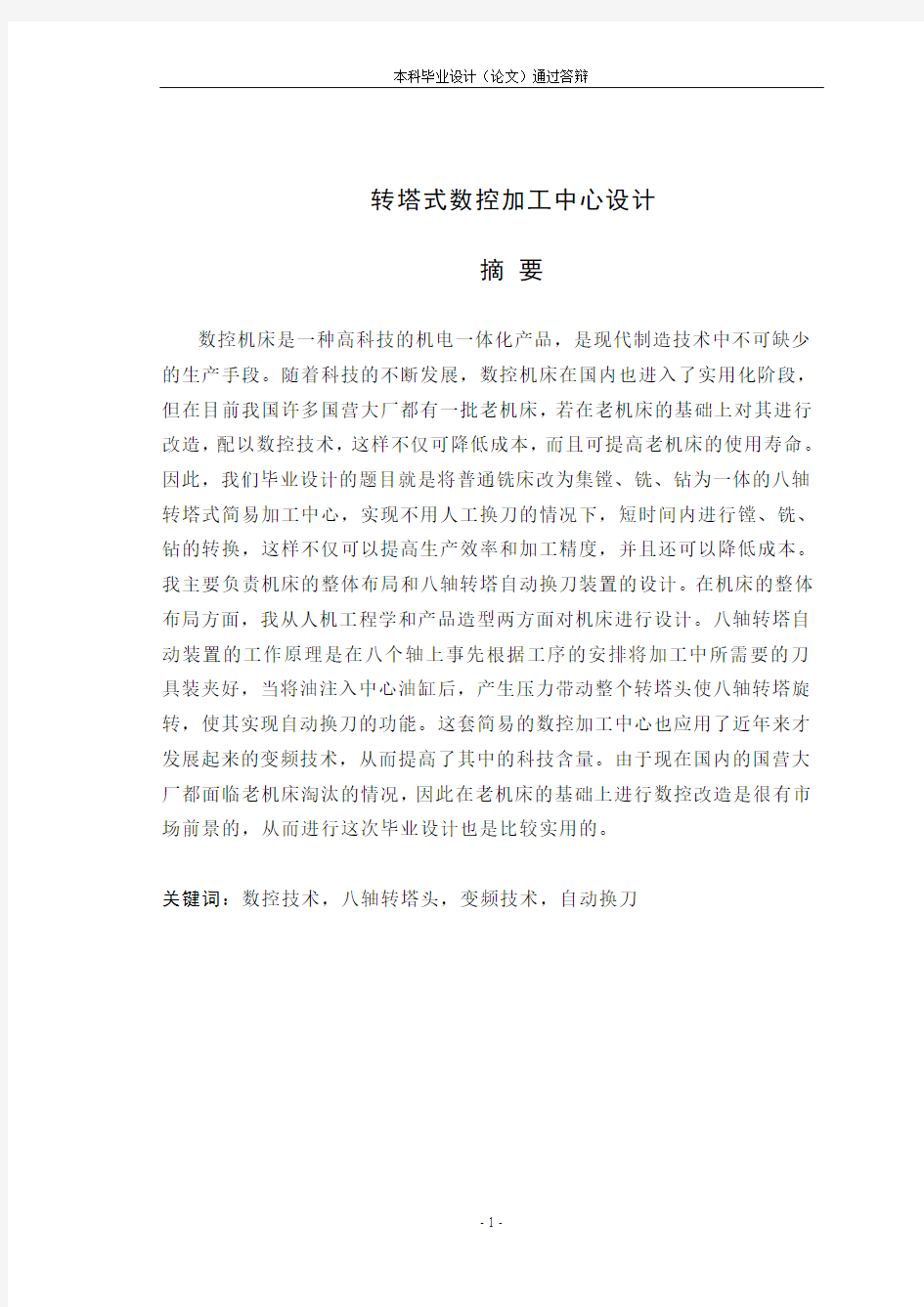
数控机床的部分进行设计说明书论文
- 格式:doc
- 大小:208.50 KB
- 文档页数:40


转塔式数控加工中心设计
摘要
数控机床是一种高科技的机电一体化产品,是现代制造技术中不可缺少的生产手段。随着科技的不断发展,数控机床在国内也进入了实用化阶段,但在目前我国许多国营大厂都有一批老机床,若在老机床的基础上对其进行改造,配以数控技术,这样不仅可降低成本,而且可提高老机床的使用寿命。因此,我们毕业设计的题目就是将普通铣床改为集镗、铣、钻为一体的八轴转塔式简易加工中心,实现不用人工换刀的情况下,短时间内进行镗、铣、钻的转换,这样不仅可以提高生产效率和加工精度,并且还可以降低成本。我主要负责机床的整体布局和八轴转塔自动换刀装置的设计。在机床的整体布局方面,我从人机工程学和产品造型两方面对机床进行设计。八轴转塔自动装置的工作原理是在八个轴上事先根据工序的安排将加工中所需要的刀具装夹好,当将油注入中心油缸后,产生压力带动整个转塔头使八轴转塔旋转,使其实现自动换刀的功能。这套简易的数控加工中心也应用了近年来才发展起来的变频技术,从而提高了其中的科技含量。由于现在国内的国营大厂都面临老机床淘汰的情况,因此在老机床的基础上进行数控改造是很有市场前景的,从而进行这次毕业设计也是比较实用的。
关键词:数控技术,八轴转塔头,变频技术,自动换刀
SLEEVE BEARINGS
BEARING MATERIALS
The antifriction properties of rubbing pairs are considered in conjunction with the materials of the shaft and bearing, and the lubricant.
Bearing materials are chosen for application in a pair with a steel or, much less frequently, cast iron shaft journal. Owing to the fact that the cost of shafts is, as a rule, higher than that of the bearing liners (especially in the case of crankshafts and other main shafts), their wear must be less than that of the liners. The higher the hardness of the shaft journals, the more reliable their performance. As a rule, journals are hardened. Journals running in high-speed bearings are hardened to a high hardness, 55 to 60 Rc (following carburizing).
Integrated requirements, complying with the basic criteria of bearing performance, can be made to bearing materials. Thus, they must:
(a) be antifrictional, a property characterized by the coefficient of friction in operation in a pair with the material of the shaft journal, and by the temperature at the working surface; (b) have high wear resistance; and (c) have high fatigue strength.
Of importance in meeting these integrated requirements are the following basic properties of bearing materials:
(a) thermal conductivity, to provide intensive heat disposal from the friction surfaces, and a low coefficient of linear expansion to avoid large changes in the clearances in the bearings during operation;
(b) capacity for being run in readily, which reduces edge and local pressures resulting from elastic deformation and errors in manufacture;
(c) good wettability with oil and the capacity for forming stable and rapidly restorable oil films on its surfaces;
(d) good corrosion resistance;
(e) low modulus of elasticity.
Also of basic importance are processing properties, such as castability, machinability, etc.
The most favorable structure for an antifriction material is one having a plastic matrix into which hard components are embedded.